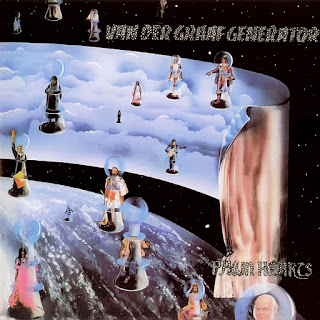Pawn Hearts is the fourth album by English progressive rock band Van der Graaf Generator, released in October 1971 on Charisma Records. The original album features just three tracks, including the side-long suite "A Plague of Lighthouse Keepers". The album was not commercially successful in the UK, but reached number one in Italy. It has since seen retrospective critical praise and was reissued on CD in 2005 with extra material.
The songs for the album were worked out while on tour in 1971, with further development and arranging at manager Tony Stratton-Smith's house in Crowborough, Sussex over a two-month period. The original plan had been to release more material, making up a double album, but Charisma vetoed the idea. A non-album single, "Theme One" was included on some releases in the US and Canada. The album's strong commercial showing in Italy resulted in a number of lucrative promotional tours there, but the resulting pressure led to the band's split in August 1972.
By 1971, Van der Graaf Generator's line-up had stabilised as frontman and songwriter Peter Hammill, saxophonist David Jackson, organist and bassist Hugh Banton and drummer Guy Evans. The group had been gigging extensively and became close friends after a particularly gruelling tour of Germany. Hammill wrote "A Plague of Lighthouse Keepers" during the tour, and the group began performing "Man-Erg" towards its end. To alleviate the tedium of touring, the group invented games including "Crowborough Tennis" which involved bouncing a ball off a table, a photograph of which was eventually used as the inner sleeve for the album.
Following the tour and in preparation for the album, Hammill invited producer John Anthony to his home, where Hammill played songs intended for the album unaccompanied on acoustic guitar and piano, allowing Anthony to take recording notes. "Man Erg" was written about the conflict between good and evil, represented as "angels" and "killers" in the song. "A Plague of Lighthouse Keepers" was inspired by Hammill's fascination with the sea, and the narrative is about a lighthouse keeper who keeps seeing people die offshore. He feels guilty about not being able to help, and the song's ending is left open, leaving the listener to decide if the keeper has committed suicide or rationalised events to live in peace. Banton was against putting "A Plague of Lighthouse Keepers" on the album, wanting more commercial material such as the previous album H to He, Who Am the Only One's "Killer", but after a band meeting he agreed to rehearse the song and worked out an arrangement. The group moved to manager Tony Stratton-Smith's house, Luxford House, Crowborough, Sussex for two months in summer 1971 to rehearse material.

















No hay comentarios.:
Publicar un comentario